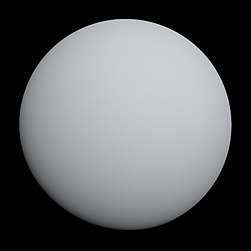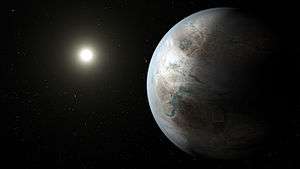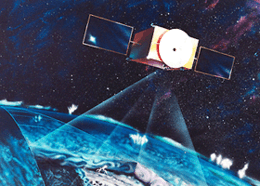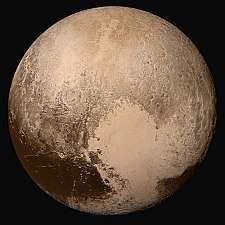EPIC 2037 c
| Exoplanet | List of exoplanets
| |||||
|---|---|---|---|---|---|---|
| Parent star | ||||||
| Star | EPIC 2037 | |||||
| Constellation | Scorpius | |||||
| Right ascension | (α) | 16h 10m 17.6973s[1] | ||||
| Declination | (δ) | −24° 59′ 25.269″[1] | ||||
| Distance | 540±20[1] ly (164±7[1] pc) | |||||
| Mass | (m) | 1.12 (± 0.05)[2] M☉ | ||||
| Radius | (r) | 1.21 (± 0.11)[2] R☉ | ||||
| Temperature | (T) | 5743.0 (± 60.0)[2] K | ||||
| Metallicity | [Fe/H] | 0.42 (± 0.04)[2] | ||||
| Age | 5.0 (± 1.8)[2] Gyr | |||||
| Physical characteristics | ||||||
| Mass | (m) | 27.0 ± 6.9[3] M⊕ | ||||
| Radius | (r) | 7.82 ± 0.72[3] R⊕ | ||||
| Density | (ρ) | 310 ± 120 kg m−3 | ||||
| Temperature | (T) | 606.0 K (332.9 °C; 631.1 °F) | ||||
| Orbital elements | ||||||
| Semi-major axis | (a) | 0.247 (± 0.004)[2] AU | ||||
| Eccentricity | (e) | 0[2] | ||||
| Orbital period | (P) | 42.3633 (± 0.0006)[2] d | ||||
| Inclination | (i) | 89.76 (± 0.2)[2]° | ||||
| Discovery information | ||||||
| Discovery date | Nov. 17, 2015 | |||||
| Discoverer(s) | PETIGURA E., HOWARD A., LOPEZ E., DECK K., FULTON B. et al.[2][3] | |||||
| Discovery method | Transit | |||||
| Discovery site | Kepler Space Observatory | |||||
| Discovery status | Confirmed | |||||
EPIC 2037 c[2] also known as EPIC 203771098 c is an exoplanet orbiting the Sun-like star EPIC 203771098 every 42 days. It has a density far lower than that of Saturn,[3] which indicates that the planet is clearly a gas giant.
References
- 1 2 3 4 Brown, A. G. A; et al. (2016). "Gaia Data Release 1. Summary of the astrometric, photometric, and survey properties". Astronomy and Astrophysics. 595. A2. arXiv:1609.04172. Bibcode:2016A&A...595A...2G. doi:10.1051/0004-6361/201629512. Gaia Data Release 1 catalog entry
- 1 2 3 4 5 6 7 8 9 10 11 "Planet EPIC 2037 b". exoplanet.eu. Archived from the original on 2015-11-24. Retrieved 2015-10-17.
- 1 2 3 4 Petigura, Erik A.; et al. (14 November 2015). "Two Transiting Low Density Sub-Saturns from K2". The Astrophysical Journal. 818: 36. arXiv:1511.04497. Bibcode:2016ApJ...818...36P. doi:10.3847/0004-637X/818/1/36.
This article is issued from
Wikipedia.
The text is licensed under Creative Commons - Attribution - Sharealike.
Additional terms may apply for the media files.




